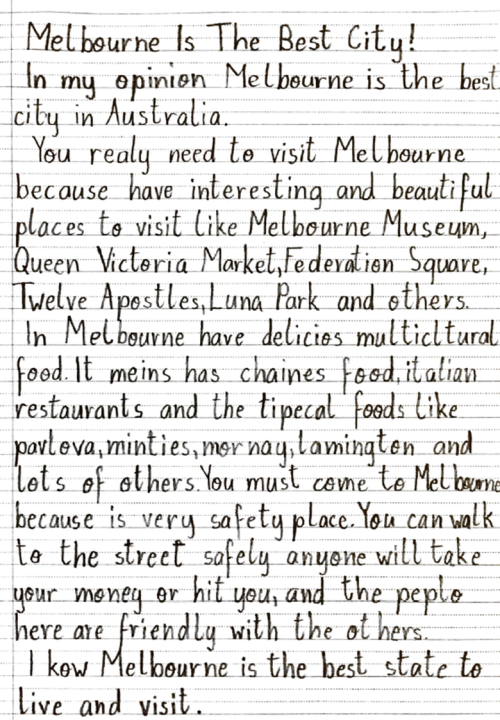Student information
The student is 10 years old and in Year 5. She was born in Brazil and speaks Portuguese. She has had age-equivalent schooling in Brazil and is able to read and write in Portuguese. She has been at an English language school in Australia for two terms and her parents are able to support her to learn English at home.
Task
Students have been learning about Australia including the states and territories, capital cities and places of interest. Students also looked at voicing opinions (agree and disagree) and supporting their opinions with reasons. For this task, students were given the topic as their opinion and asked to write a text to persuade their friends or family to come and visit Melbourne. The class had explored the structure of a persuasive text prior to writing. Key vocabulary was provided on flashcards with pictures.
The student completed the task independently using the flashcards and text structure discussed.
The analysis is based on the student’s writing before correction.

Text
Melbourne Is The Best City!
In my opinion, Melbourne is the best city in Australia.
You realy need to visit Melbourne because have interesting and beautiful places to visit like Melbourne Museum, Queen Victoria Market, Federation Square, Twelve Apostles, Luna Park and others.
In Melbourne have delicios multicltural food. It meins has chaines food, italian restuarants and the tipecal foods like pavlova, minties, mornay, lamington and lots of others. You must come to Melbourne because is very safety place. You can walk to the street safely anyone will take your money or hit you, and the peplo here are friendly with the others.
I kow Melbourne is the best state to live and visit.
This sample of student work demonstrates that the student can:
- Write using language that is beginning to reflect the features of written language more than the features of spoken language (VCEALA379)
- Use knowledge of written or spoken home language texts to form new English texts (VCEALA385) *pattern of spelling errors indicates possible transferral of knowledge from home language, for example delicios, meins and chaines
- Use heading and text formats appropriate to the task (VCEALA387)
- Write sentences with some common errors (VCEALL390)
- Use a range of verb forms correctly (VCEALL391)
- Use a number of common conjunctions to link ideas to create compound and complex sentences (VCEALL393)
- Use modelled vocabulary appropriately (VCEALL395)
- Select some descriptive vocabulary appropriate to the context (VCEALL396)
- Spell frequently used words with common patterns with increased accuracy (VCEALL398)
- Experiment with complex punctuation (VCEALL399)
Overall, this student can also:
- Write simple texts that present a point of view (VCEALC377)
- Create a small range of texts based on modelling (VCEALA380) Possible next steps for this student's learning
- Using the TEEL framework (Topic sentence, Explanation, Evidence, Linking sentence) to help provide more information in one paragraph (VCEALL388)
- Using a writing plan based on the TEEL framework to organise the content for all the paragraphs in an essay so that there is cohesion throughout the whole essay (VCEALA381)
- Using comparative language and superlative language such as is better than... and has the most amazing... (VCEALL392)
Pathways and transitions considerations
A Year 5 student working within the range of Level B2 in any one language mode is not ready to transition to the English curriculum regardless of their proficiency in the other two language modes. This student will continue on Pathway B of the EAL curriculum in all language modes.